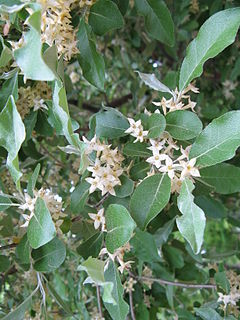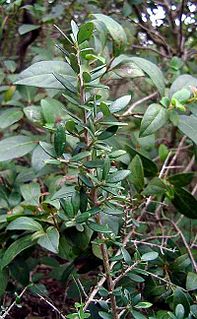
The olive, known by the botanical name Olea europaea, meaning "European olive", is a species of small tree in the family Oleaceae, found in the Mediterranean Basin from Portugal to the Levant, the Arabian Peninsula, and southern Asia as far east as China, as well as the Canary Islands and Réunion. The species is cultivated in many places and considered naturalized in all the countries of the Mediterranean coast, as well as in Argentina, Saudi Arabia, Java, Norfolk Island, California, and Bermuda. Olea europaea is the type species for the genus Olea.

The Oleaceae are a family of flowering plants in the order Lamiales. It presently comprises 26 genera, one of which is recently extinct. The 25 extant genera include Cartrema, which was resurrected in 2012. The number of species in the Oleaceae is variously estimated in a wide range around 700. The Oleaceae consist of shrubs, trees, and a few lianas. The flowers are often numerous and highly odoriferous. The family has a subcosmopolitan distribution, ranging from the subarctic to the southernmost parts of Africa, Australia, and South America. Notable members of the Oleaceae include olive, ash, jasmine, and several popular ornamental plants including privet, forsythia, fringetrees, and lilac.

The Elaeagnaceae are a plant family, the oleaster family, of the order Rosales comprising small trees and shrubs, native to temperate regions of the Northern Hemisphere, south into tropical Asia and Australia. The family has about 60 species in three genera.

Elaeagnus umbellata is known as Japanese silverberry, umbellata oleaster, autumn olive, autumn elaeagnus, or spreading oleaster. The species is indigenous to eastern Asia and ranges from the Himalayas eastwards to Japan.

Olea is a genus of about 40 species in the family Oleaceae, native to warm temperate and tropical regions of the Middle East, southern Europe, Africa, southern Asia, and Australasia. They are evergreen trees and shrubs, with small, opposite, entire leaves. The fruit is a drupe. Leaves of Olea contain trichosclereids.

Frankia is a genus of nitrogen-fixing, filamentous bacteria that live in symbiosis with actinorhizal plants, similar to the Rhizobium bacteria found in the root nodules of legumes in the family Fabaceae. Bacteria of this genus also initiate the forming of root nodules.
Oleaster, signifying a plant like an olive, but less valuable, may be applied to:

Olea capensis, also known by the common name black ironwood, is an African tree species belonging to the Olive family (Oleaceae). It is widespread in Sub-Saharan Africa from the east in Somalia, Ethiopia and Sudan, south to the tip of South Africa, and west to Cameroon, Sierra Leone and the Islands of the Gulf of Guinea, as well as Madagascar and the Comoros. It occurs in bush, littoral scrub and evergreen forest.

Olea europaea subsp. cuspidata is a subspecies of olive previously described as Olea cuspidata and Olea africana. It has various common names, including wild olive, brown olive, Indian olive, Olienhout and iron tree.

Olea paniculata, commonly known as the native olive, is a plant of the genus Olea and a relative of the olive. It grows natively in Pakistan and southwestern China (Yunnan) through tropical Asia to Australia and the Pacific islands of New Caledonia, Vanuatu and Lord Howe Island.

The Aglandau is one of the more important of approximately a hundred cultivars of olives in France. It is grown primarily in Provence, but also as far away as Azerbaijan and Ukraine. The 'Aglandau' is primarily used for production of oil, but can also be eaten. When used as table olives, the fruit is normally called Beruguette. The oil is highly valued for its fruity taste.
Silverthorn may refer to:

Olea oleaster, the wild-olive, has been considered by various botanists a valid species and a subspecies of the cultivated olive tree, Olea europea, which is a tree of multiple origins that was domesticated, it now appears, at various places during the fourth and third millennia BCE, in selections drawn from varying local populations. The wild-olive, which ancient Greeks distinguished from the cultivated olive tree, was used to fashion the olive wreath awarded victors at the ancient Olympic games. The ancient and sacred wild-olive tree of Olympia stood near the Temple of Zeus, patron of the games.

Elaeagnus pungens is a species of flowering plant in the family Elaeagnaceae, known by the common names thorny olive, spiny oleaster and silverthorn; also by the family name "oleaster". It is native to Asia, including China and Japan. It is present in the southeastern United States as an introduced species, a common landscaping and ornamental plant, and sometimes an invasive species.

Olea woodiana, known commonly as the forest olive or black ironwood, is an African tree species belonging to the olive family (Oleaceae).
Olea hochstetteri is a species of tree of the Oleaceae family, often considered a subspecies of Olea capensis. Like the related species Olea welwitschii, it grows in sandy desert regions of Kenya, Tanzania and Uganda. It is an inconspicuous plant that does not attain great height, in contrast to O. welwitschii which can attain a height of 25m.














